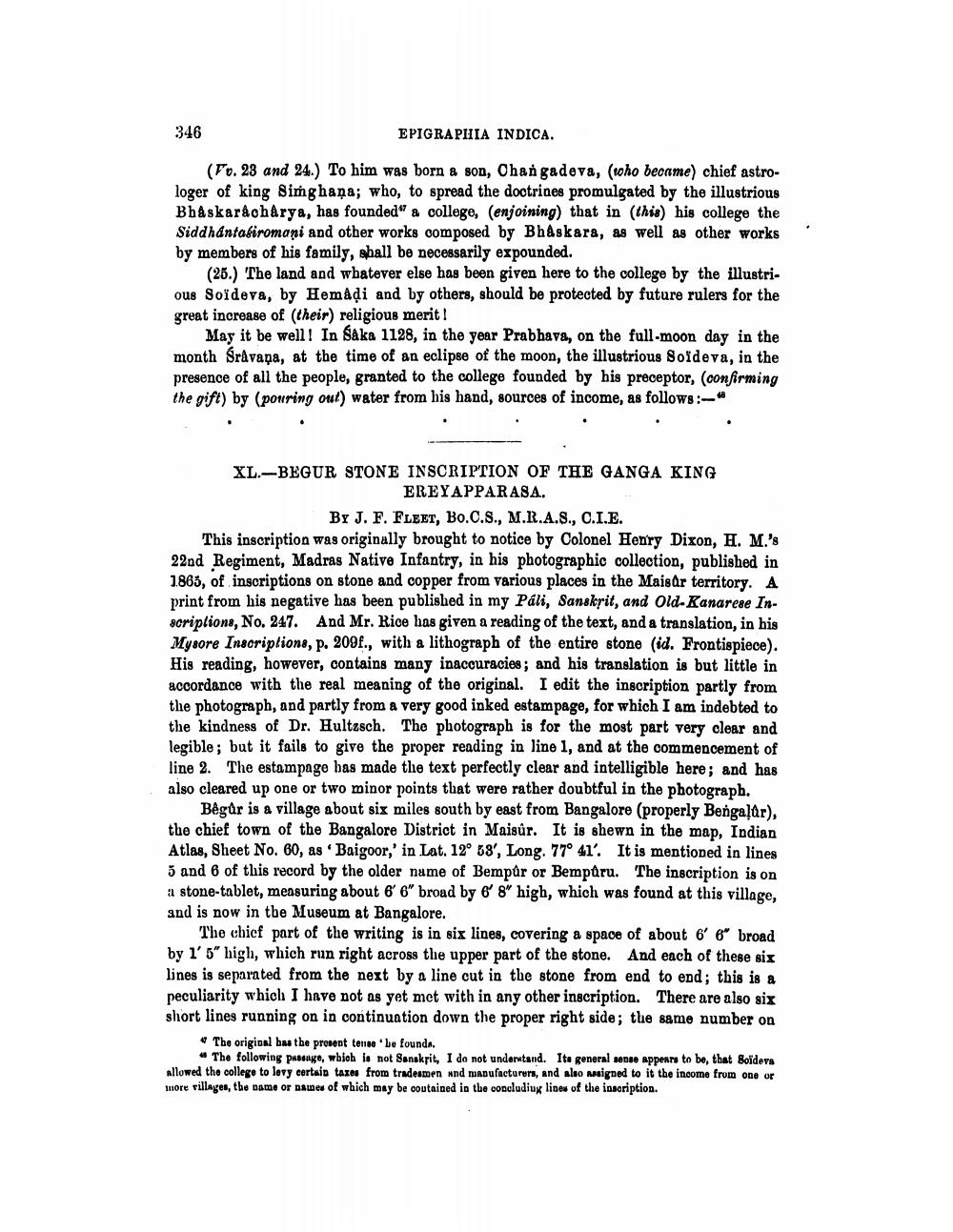________________
346
EPIGRAPHIA INDICA.
(Fv. 23 and 24.) To him was born a son, Changadeva, (who became) chief astrologer of king Simghana; who, to spread the doctrines promulgated by the illustrious Bhaskaracharya, has founded" a college, (enjoining) that in (this) his college the Siddhantasiromani and other works composed by Bhaskara, as well as other works by members of his family, shall be necessarily expounded.
(25.) The land and whatever else has been given here to the college by the illustrious Soïdeva, by Hemaḍi and by others, should be protected by future rulers for the great increase of (their) religious merit!
May it be well! In Saka 1128, in the year Prabhava, on the full-moon day in the month Sravana, at the time of an eclipse of the moon, the illustrious Soïdeva, in the presence of all the people, granted to the college founded by his preceptor, (confirming the gift) by (pouring out) water from his hand, sources of income, as follows:
XL-BEGUR STONE INSCRIPTION OF THE GANGA KING EREYAPPARASA.
By J. F. FLEET, Bo.C.S., M.R.A.S., C.I.E.
This inscription was originally brought to notice by Colonel Henry Dixon, H. M.'s 22nd Regiment, Madras Native Infantry, in his photographic collection, published in 1.865, of inscriptions on stone and copper from various places in the Maisûr territory. A print from his negative has been published in my Páli, Sanskrit, and Old-Kanarese Inscriptions, No. 247. And Mr. Rice has given a reading of the text, and a translation, in his Mysore Inscriptions, p. 200f., with a lithograph of the entire stone (id. Frontispiece). His reading, however, contains many inaccuracies; and his translation is but little in accordance with the real meaning of the original. I edit the inscription partly from the photograph, and partly from a very good inked estampage, for which I am indebted to the kindness of Dr. Hultzsch. The photograph is for the most part very clear and legible; but it fails to give the proper reading in line 1, and at the commencement of line 2. The estampage has made the text perfectly clear and intelligible here; and has also cleared up one or two minor points that were rather doubtful in the photograph.
Bêgûr is a village about six miles south by east from Bangalore (properly Bengalur), the chief town of the Bangalore District in Maisûr. It is shewn in the map, Indian Atlas, Sheet No. 60, as 'Baigoor,' in Lat. 12° 53', Long. 77° 41'. It is mentioned in lines 5 and 6 of this record by the older name of Bempûr or Bempâru. The inscription is on a stone-tablet, measuring about 6' 6" broad by 6' 8" high, which was found at this village, and is now in the Museum at Bangalore.
The chief part of the writing is in six lines, covering a space of about 6' 6" broad by 1' 5" high, which run right across the upper part of the stone. And each of these six lines is separated from the next by a line cut in the stone from end to end; this is a peculiarity which I have not as yet met with in any other inscription. There are also six short lines running on in continuation down the proper right side; the same number on
The original has the present tense be founds.
The following passage, which is not Sanskrit, I do not understand. Its general sense appears to be, that Soïdeva allowed the college to levy certain taxes from tradesmen and manufacturers, and also assigned to it the income from one or more villages, the name or names of which may be coutained in the concluding lines of the inscription.




